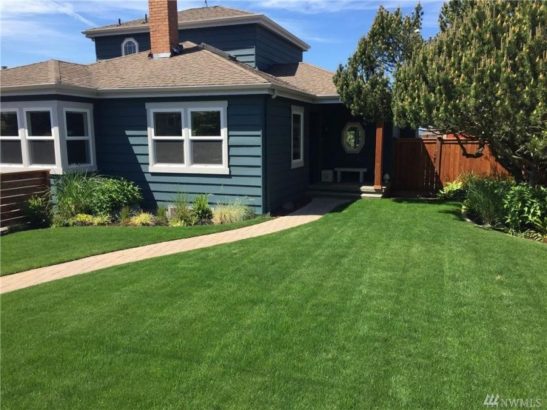Written by Eugene Bryson

Winter won’t last forever. Shoveling snow is part of life in Seattle, but winter is also a good time to get your lawn ready for spring.
Maintaining a healthy lawn showcases your home as a sparkling gem in a golden neighborhood. And with Seattle growing by leaps and bounds, your jewel of a home and yard will stand out for would-be new homeowners.
Here’s how to get your yard in shape for spring and summer:
Perk up the Mower

These cooler months are a good time to do what you forgot to do at the end of the last growing season … spruce up the mower.
- Clean or replace spark plugs.
- Sharpen blades every season (it’s safer and easier to have a professional do this).
- Refer to the owner’s manual for replacing oil and filters. If your mower has a deck, clean off the grass and mud from past use.
End result: A clean mower with sharp blades will speed up your mowing time and give your lawn a cleaner cut.
Know Your Grass

Knowing which type of grass is covering your yard is the key to knowing how to seed and treat it. In Seattle, most lawns consist of cool-season grass blends of Kentucky bluegrass, tall and fine fescues, and ryegrass.
Bentgrass also grows well in the area, especially in bright sunlight. Hardy cool-season grasses thrive in Seattle’s cold winters because the vast Pacific Northwest/Cascade region is in USDA Plant Hardiness Zones 6 through 9.
Seed, Feed, and Weed

If you didn’t overseed before Seattle’s first fall frost, spread some cool-season grass seed after the last frost. The seeds should germinate within a few weeks and fill in those bare spots.
Applying a slow-release fertilizer in the fall and spring helps grass seeds germinate and develop strong roots.
Chemical fertilizers work faster, but organic matter promotes ecological health. Natural fertilizers such as compost, grass clippings, minced leaves, and decaying tree bark will not pollute nearby water sources.
Before fertilizing, test the soil to determine its pH balance. (The WSU extension office offers test kits, and they’re also available at garden and hardware stores.) On a scale of 1 to 14, anything below 6 is acidic, and above 8 is moving toward alkaline. The neutral zone of 6.0 to 7.0.
Pre-emergent herbicides kill late summer and fall seeds floating around that produce weeds in spring. While they won’t completely rid your lawn of dandelions, weed killers can reduce the numbers.
Toil Over the Soil

It may be difficult to see problems in the soil after the snow flies, but signs are evident on warmer days. Brown or yellow patches in the sod may be signs of fertilizer burn, deep cutting with a mower blade, dog urine, disease, or insect damage.
Water, time, and new growth will help alleviate problems, but lawns with disease and pest damage must be treated.
Winter Lawn Maintenance
Maintaining your lawn throughout the winter will ensure it comes out of dormancy green and lush.
- Pick up twigs, branches, dead tree limbs, and other debris.
- Rake thatch and dead grass.
- Remove dead foliage and grass. If some of it is already frozen to the ground, don’t worry — decaying vegetative matter makes great fertilizer.
- Wrap the trunks of young trees for warmth and wind protection.
- Nourish and fertilize garden bed soil with compost.
- Trim back trees and shrubs.
- Aerate compacted soil for grass roots to breathe. GrassCycling – leaving grass clippings on the lawn after a mow — provides natural compost.
Pass the Buck?
Doing all these projects yourself in fall, winter, spring, and summer can be difficult and a bit overwhelming. Keep in mind: You’ll also need to trim the shrubs and trees and weed and clean out the flower bed. But with the average cost of Seattle landscaping at $208 per month, hiring a professional means you’ll spend more time enjoying your yard, and less time maintaining it.
Eugene Bryson is a freelance writer, landscaper, and home inspector. As a Washington native, he roots for the Mariners to one day make it to the World Series.


Leave a Reply